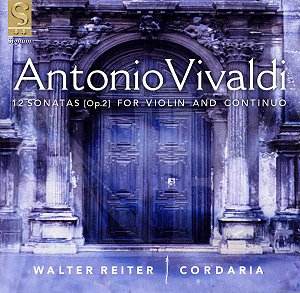|
|
Search MusicWeb Here |
|
 |
||
|
Founder:
Len Mullenger (1942-2025) Editor
in Chief:John Quinn
|
|
|
Search MusicWeb Here |
|
 |
||
|
Founder:
Len Mullenger (1942-2025) Editor
in Chief:John Quinn
|
 |
Antonio VIVALDI (1678-1741)
12 Sonatas for Violin and Continuo, Op. 2 Shalev Ad-El (Harpsichord) Katherine Sharman (Cello) Lynda Sayce (Theorbos and guitar) |
| CD available for post-free online mail-order or you may download individual tracks. For some labels you can download the entire CD with a single click and make HUGE savings. The price you see is the price you pay! The full booklet notes are available on-line. |  |
|
NOTE • Click on the button and you can buy the disc or read the booklet details • You can also access each track which you may then sample or down load. • Further Information. |
|
|
These works, often thought of in terms of being ‘immature’, are currently under recorded. This is a pity because although lacking in the depth of Vivaldi’s next opus, the masterwork ‘L’Estro armonico’, these sonatas are sophisticated and artful studies.
Taking the rhythms and melodies from dance movements Vivaldi creates a showcase for the violin and explores the interplay between the base instruments of cello and harpsichord. The movements contrast stately, formal preludes with rustic and immediate dances. The exuberance of the faster movements encourages technical brilliance and the slower ones require a thoughtfulness from the player. There is in this music a real sense of Vivaldi striving to stretch the sonata form and to give the music a depth of meaning.
Walter Reiter and Cordaria are well aware of the complexity of the music and they play with great understanding and feeling.
Reiter’s violin playing is often very fine. He plays on a 1727 original instrument and the tone is beautiful. His playing elicits a tender, arching line from the music. Only sounding occasionally slightly acerbic, as such original instruments can sometimes sound, he manages to play with a simplicity very much in keeping with the period. His playing of the slow preludes is particularly sympathetic and he does not over embellish the eighteenth century frills. He is always expressive and never gaudy. Reiter does seem rather halting, however, at times when he is approaching some of the ornamentation and you can almost hear him preparing for the ‘hurdle’. With his sensitive, aristocratic playing he also seems to have more affinity with the slow preludes than with the dances and faster movements. He brings out a ‘rustic squeakiness’ when engaging with Vivaldi’s taste for the Italian pastoral, as in Sonata No. 4 the ‘Corrente Presto’, and brings with it the texture and colour of folk music.
The cello and harpsichord playing, too is adroit and perceptive. The instruments are evenly balanced with the violin, but Cordaria ensure that the listener is aware of the importance of the accompaniment. At the ‘Corrente Allegro’ in Sonata No. 1 the players subtly display the growing discourse between the instruments. There is nice texture here too - the harpsichord and cello are copies of original instruments from the eighteenth and seventeenth century instruments - with the harpsichord quite gruff as it takes on its own voice, and as the instruments compete to enjoy the lively vivacity of the music. Later, in the ‘Corrente Allegro’ of the Sonata No. 3, the cello nicely underlines the violin in subtle agreement, but then also expresses freedom through the delicate contrapuntal rhythms.
In the booklet notes Cordaria state that they are ‘..dedicated to the…solo violin repertoire from the baroque period..’ and it is clear that they enjoy and understand the music. This is a fresh and intelligent performance, which could easily compete with a more accomplished, virtuoso recording. The players acknowledge Vivaldi’s drive to create a meaningful piece within the constraints of the sonata form and they give a nice feeling of time and place too.
The recording and sound quality is very good.
This is, then, an enjoyable disc which encourages interest in the work and should prompt further and more varied recorded interpretations. See also review by Kirk McElhearn
|
Sonata No.1
for Violin and Continuo in G Sonata No.2
for Violin and Continuo in A Major Sonata No.4
for Violin and Continuo in F Major Get a free QuickTime download here |
|
ADDITIONAL INFORMATION •
You can sample only 30 seconds (or 15% if that is longer) of a given track. Select from the View tracks list. Each sample will normally start from the beginning but you can drag the slider to any position before pressing play. • PLEASE NOTE: If you are behind a firewall and the sound is prematurely terminated you may need to register Ludwig as a trusted source with your firewall software.
•You will need Quicktime to hear sound samples. Get a free Quicktime download here • If you cannot see the "Sample All Tracks" button you need to download Flash from here.
|
|
|
Return to Index |